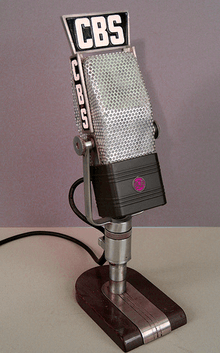Ribbon microphone


A ribbon microphone, also known as a ribbon velocity microphone, is a type of microphone that uses a thin aluminum, duraluminum or nanofilm of electrically conductive ribbon placed between the poles of a magnet to produce a voltage by electromagnetic induction. Ribbon microphones are typically bidirectional, meaning that they pick up sounds equally well from either side of the microphone.
Principle of operation

In a moving-coil microphone, the diaphragm is attached to a light movable coil that generates a voltage as it moves back and forth between the poles of a permanent magnet. In ribbon microphones, a light metal ribbon is suspended between the poles of a magnet. As the ribbon vibrates, a voltage is induced at right angles to both the ribbon velocity and magnetic field direction and is picked off by contacts at the ends of the ribbon. Ribbon microphones are also called "velocity microphones" because the induced voltage is proportional to the velocity of the ribbon and thus of the air particles in the sound wave, unlike in some other microphones where the voltage is proportional to the displacement of the diaphragm and the air.
The advantage of the ribbon microphone when introduced was that the light ribbon had a much higher natural resonant frequency than diaphragms in existing microphones, above hearing range, so it had flatter response at high frequencies. The voltage output of older ribbon microphones is typically quite low compared to a dynamic moving coil microphone, and a step-up transformer is used to increase the voltage output and increase the output impedance. Modern ribbon microphones do not suffer from this problem due to improved magnets and more efficient transformers and have output levels that can exceed typical stage dynamic microphones.[1]

Ribbon microphones were once delicate and expensive, but modern materials make certain present-day ribbon microphones very durable, and so they may be used for loud rock music and stage work. They are prized for their ability to capture high-frequency detail, comparing very favorably with condenser microphones, which can often sound subjectively "aggressive" or "brittle" in the high end of the frequency spectrum. Due to their bidirectional pick-up pattern, ribbon microphones are often used in pairs to produce the Blumlein Pair recording array. In addition to the standard bidirectional pick-up pattern, ribbon microphones can also be configured to have cardioid, hypercardioid, omnidirectional, and variable polar patterns, although these configurations are much less common.[2]
As many mixers are equipped with phantom power in order to enable the use of condenser microphones, care should be taken when using condenser and ribbon microphones at the same time. If the ribbon microphone is improperly wired, which is not unheard of with older microphones, this capacity can damage some ribbon elements;[2] however, improvements in designs and materials have made those concerns largely inconsequential in modern ribbon microphones.[3]
History

In the early 1920s, Drs. Walter H. Schottky and Erwin Gerlach co-invented the first ribbon microphone.[4] By turning the ribbon circuit in the opposite direction, they also invented the first ribbon loudspeaker. A few years later, Dr. Harry F. Olson of RCA started developing ribbon microphones using field coils and permanent magnets. The RCA Photophone Type PB-31 was commercially manufactured in 1931, greatly impacting the audio recording and broadcasting industries. Condenser microphones at the time could not compare to its frequency response. Radio City Music Hall employed PB-31s in 1932.[5] The following year, the 44A came on the scene. Its tone and pattern control helped reduce reverberation. Many RCA ribbon models are still in use and valued by engineers.[6]
The BBC-Marconi Type A was an iconic ribbon microphone produced by the BBC and Marconi between 1934 and 1959.[7] Also of note is the ST&C Coles 4038 (or PGS – pressure gradient single), designed by the BBC in 1954 and still used for some applications to this day. Its historical uses varied from talks to symphony concerts, and it is regarded as a delicate, fine traditional microphone.[8]
Around 2002, relatively inexpensive ($80 – $200) Chinese-manufactured ribbon microphones inspired by the RCA-44 and older Russian Oktava ribbon microphones became available.[9]
In 2007, microphones employing ribbon elements made of strong nanomaterials became available, offering orders of magnitude improvement in signal purity and output level.[10]
The ribbon microphone is an electrically simple design with no active circuitry; it is possible to build one from a kit, or with basic tools and materials.[11] The acoustic complexity of ribbon microphones is comparable to other types of air coupled transducers.
See also
References
- ↑ James B. Calvert (2003-08-31). "Microphones". Retrieved 2011-01-22.
- 1 2 Ken Lanyon (2001-03-15). "Recording Engineer's Quarterly, March 2001". Recordingeq.com. Retrieved 2011-01-22.
- ↑ Tomi Engdahl (1997–2000). "Powering microphones". Retrieved 2011-01-22.
- ↑ "Walter Schottky". 2003-06-03. Archived from the original on 2009-10-25. Retrieved 2011-01-22.
- ↑ Jim Webb. "Twelve Microphones That Made History". Retrieved 2011-11-19.
- ↑ 1931 Harry F. Olson and Les Anderson, RCA Model 44 Ribbon Microphone, Mix Magazine, 2006-09-01, retrieved 2011-01-22
- ↑ S. O. Coutant (1951-09-21). "The British Broadcasting Corporation Type AX Marconi Ribbon Microphone". Coutant.org. Retrieved 2011-01-22.
- ↑ Stephen Murphy (2004-01-01). "Coles Electroacoustics 4040 Studio Ribbon Microphone". Pro Audio Review. Retrieved 2011-01-22.
- ↑ Lynn Fuston, The Chinese Connection, EQ Magazine, retrieved 2011-01-22
- ↑ Efrain Viscarolasaga (2008-02-11), Local firms strum the chords of real music innovation, Mass High Tech: The Journal of New England Technology, retrieved 2015-04-17
- ↑ Matthew Shechmeister (Jan 2011), Ribbon Microphones: Audio Icon You Can Build in Your Garage, Wired.com, retrieved 2011-01-22